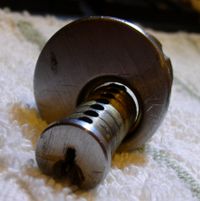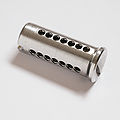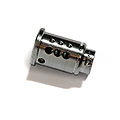Plug
Plug

The plug (or core) is the movable piece of a locking cylinder, located in the middle of the cylinder itself. The plug's movement is restricted by the locking components until all components are in the correct position through the action of a key. Once the plug can rotate, it actuates the locking bolt to retract or extend, thus locking or unlocking the lock.
History
The plug was first invented by Linus Yale, Jr. during the creation of the Yale Cylinder Lock in the mid-1800s.
Design changes since Yale's time have been relatively minor and usually only to accomodate secondary locking mechanisms, such as sidebars or side pins.
Resistance to Compromise
Because the plug is integral to the security of the locking system many security enhancements exist to protect against various attacks.
- A round mating surface with the cylinder. This improves tolerance between the plug and cylinder to improve picking resistance.
- A lip or bevel on the user facing end of the plug to prevent shimming and other forms of bypass. This also makes disassembly easier by only allowing the plug to be removed and inserted in one direction.
- Ball bearings to prevent destructive entry in the form of drilling.
- Construction keying features, normally to catch ball-bearings from the pin chambers and provide key control during and after construction of a building.
Gallery
Goal Z plug
Goal Z plug chambers
Goal V18 plug
Goal D9 plug drilled for construction keying
Goal D9 plug
DOM ix TwinStar plug
See also
| This article is a stub. You can help Lockwiki by expanding it. |







